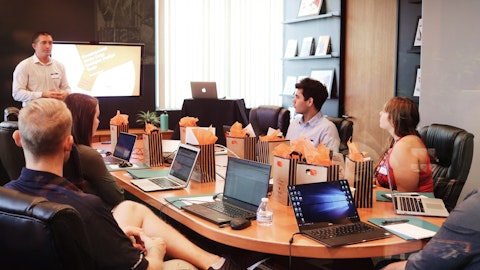Provident Financial Services, Inc. (NYSE:PFS) Q1 2023 Earnings Call Transcript April 28, 2023
Provident Financial Services, Inc. misses on earnings expectations. Reported EPS is $0.54 EPS, expectations were $0.58.
Operator: Good morning. Thank you for attending today’s Provident Financial Services Inc. First Quarter Earnings Conference Call. My name is Frances, and I’ll be your moderator today. All lines will be muted during the presentation portion of the call with an opportunity for questions and answers at the end. . I would now like to pass the conference over to our host, Adriano Duarte with Provident Financial Services. Please go ahead.
Adriano Duarte: Thank you, Frances. Good morning, everyone, and thank you for joining us for our first quarter earnings call. Today’s presenters are President and CEO, Tony Labozzetta, and Senior Executive Vice President and Chief Financial Officer, Tom Lyons. Before beginning the review of our financial results, we ask that you please take note of our standard question as to any forward looking statements that may be made during the course of today’s call. Our full disclaimers contained in this morning’s earnings release, which has been posted to our investor relations page on our website, provident.bank. Now it’s my pleasure to introduce Tony Labozzetta who will offer his perspective on the first quarter. Tony?
Tony Labozzetta: Thank you, Adriano. Good morning, everyone, and welcome to the Provident Financial Services Earnings Call. First quarter was an extraordinary time for the banking industry. What has been described as an idiosyncratic event resulted in the failure of two high profile regional banks and caused a disruption to the banking system, that can be properly termed a deposit flight prices. Presently, it appears that the volatility has moderated and the banking industry including Provident remains fundamentally strong, liquid, and well capitalized. Given this recent disruption to the banking system, out of an abundance of caution, we prudently took measures to maximize our on-balance sheet liquidity. This included increasing our cash position, using higher cost funding sources and higher costing deposit programs that provide more insurance.
Despite the current market conditions, Provident produced good financial results this quarter, which demonstrates the resiliency of our business model, strong deposit franchise and talented management team. As such, we reported earnings of $0.54 per share, an annualized return on average assets of 1.2% and a return on average tangible equity of 14.1%. Our capital is strong and comfortably exceeds well capitalized levels. Tangible book value expanded $0.52 or 3.4% during the quarter to 15.64, on the strength of our earnings and the improvement in the unrealized loss on our securities portfolio. Our tangible common equity ratio at March 31st was 8.56. As such, our Board of Directors approved a quarterly cash dividend of $0.24 per share payable on May 26.
In response to the disruption that I previously mentioned, we instituted a robust customer outreach program. I’m pleased to report that these efforts will well received by our customers. We identified a limited amount of deposit outflows that were directly associated with the deposit flight prices. Presently, Our uninsured deposits are $2.9 billion or approximately 29% of our total deposits. Our on balance sheet liquidity plus our bowering capacity is $3.7 billion or 126% of uninsured deposits. Our core deposits are a valuable component of our franchise. During the quarter, our core deposits decreased $265 million or 2.5%, which we attribute to normal business activity, customers seeking higher rates and some outflow liquidity related to the market disruption.
For the first quarter, our deposit beta was 76%, while the rising rate cycle to-date deposit beta was about 18%. Consequently, our total cost of deposits increased and when combined with the excess liquidity previously mentioned drove our total cost of funds up 42 basis points to 1.21% and compressed our net interest margin 14 basis points. Our commercial lending team closed approximately $350 million of new commercial loans during the first quarter. However, increased — prepayments increased 61% to $283 million as compared to the trailing quarter. Approximately $116 million or 41% represented desired payoffs. A remainder were due to the sale of the underlying or refinanced elsewhere. Our credit metrics improved in the first quarter, and we continue to maintain prudent underwriting standards, particularly in our CRE lending.
In addition, our CRE monitoring processes have been enhanced with targeted in-depth initiatives to evaluate portfolio and loan level risks. Areas of focus include the office property portfolio and the construction portfolio, as well as loan level reviews for credits that are maturing or upcoming rate resets. Our line of credit utilization percentage decreased 3% in the first quarter to 31% trailing our historical average of approximately 40%. As a result of the heightened payoffs and decreased line utilization, our commercial loans remain relatively flat versus the trailing quarter. The pull-through in our commercial loan pipeline during the first quarter was good, and the gross pipeline remains strong at approximately $1.5 billion. The pull-through adjusted pipeline including loans, pending closing, is approximately $898 million.
And our projected pipeline rate remained unchanged at 6.77%. We are encouraged by the strength of our pipeline and with normal payoffs, we expect to achieve our growth targets. However, we remain mindful of a potential economic slowdown. Our fee-based businesses performed well this quarter. Provident Protection Plus had a strong first quarter with 35% organic growth, which resulted in a 26% increase in revenue and a 27% increase in operating profit as compared to the same quarter last year. The conditions in the financial markets were more stable in the first quarter. And as a result, Beacon Trust experienced growth in the market value of assets under managed and related fee income. Beacon’s fee income increased $319,000 or 4.8% as compared to the trailing quarter.
Regarding our previously announced merger with Lakeland Bancorp, our team continues to work diligently towards obtaining the regulatory approvals to combine our two companies. We are excited about this combination, which will enhance our ability to serve our customers and our communities. Looking forward, we remain focused on growing our business, staying committed to our risk management principles and integrating the merger with Lakeland Bancorp, which we believe will create value for all of our stakeholders. Now, I’ll turn the call over to Tom for his comments on our financial performance. Tom?
Tom Lyons: Thank you, Tony, and good morning, everyone. As Tony noted, our net income for the quarter was $40.5 million or $0.54 per share, compared with $49 million or $0.66 per share for the trailing quarter, and $44 million or $0.58 per share for the first quarter of 2022. Non tax deductible charges related to our pending merger of Lakeland Bancorp totaled $1.1 million in the current quarter, and $1.2 million in the trailing quarter. Excluding these merger related charges, pre-tax pre-provisioned earnings for the current quarter was $62.8 million or an annualized 1.86% of average assets. Revenue totaled $130 million for the quarter compared to $132 million for the trailing quarter, and $115 million for the first quarter of 2022.
Our net interest margin decreased 14 basis points in the trailing quarter to 3.48%. The yield on earning assets improved by 27 basis points versus the trailing quarter as floating in adjustable rate loans repriced favorably and new loan originations reflected higher market rates. This improvement in asset yields, however, was more than offset by an increase in interest bearing funding cost of 54 basis points versus the trailing quarter. Increased funding costs reflected current market conditions, which resulted in an increase in borrowings accompanied by a decrease in deposits. Certain non-interest bearing balances also move to our interest bearing insured cash sweep product in order to obtain increased deposit insurance. In addition, lower costing demand and savings balance is shifted to higher costing time deposits.
The average total cost-of-deposits increased 38 basis points to 1.05%. This represents deposit basis of 76% for the current quarter, and 18% for the rising rate cycle to date. The average cost of total interest bearing liabilities increased 54 basis points from the trailing quarter to 1.54%. While an increase in funding costs was anticipated, recent bank failures, resulting industry liquidity concerns and an increase in the attractiveness of investment alternatives have altered the competitive environment and increased depositor security and price sensitivity. As a result, we expect to see some continued net interest margin compression for the balance of 2023. Period and commercial and total loans were largely stable, decreasing $19 million and $25 million respectively for the quarter.
Our pull-through adjusted loan pipeline increased $184 million from last quarter to $898 million with a weighted average rate of 6.77% versus our current portfolio yield of 5.12%. The provision for credit losses on loans increased $2.6 million for the quarter to $6 million due or worsened economic forecast. As a result, the allowance for credit losses on loans increased to 91 basis points of total loans at March 31st from 86 basis points at December 31st. Current credit metrics, however improved with delinquencies and criticized and classified assets falling and non-performing assets — total assets declining to 36 basis points at March 31st. Net charge-offs on an annualized 3 basis points of loans for the quarter. Non-interest income increased $3.9 million versus the trailing quarter as an additional $2 million gain on a prior quarter sale of REO was realized upon the satisfaction of closing conditions of the current quarter.
In addition, our fee based business lines performed well with insurance agency and wealth management income both increased the trailing quarter. Including provisions for credit losses on commitments to extend credit and merger related charges, operating expenses were an annualized 2% of average assets for the current quarter compared to 1.79% in the trailing quarter and 1.90% for the first quarter of 2022. The efficiency ratio was 51.85% for the first quarter of 2023 compared with 46.88% in the trailing quarter and 56.05% for the first quarter of 2022. The first quarter of every year is impacted by increased employer payroll tax expense and Social Security income limits reset each calendar year. In addition, the current quarter included non-recurring charges of approximately $563,000 related to achievement projections on performance based stock compensation and $363,000 related to the conclusion of a multiyear sales tax audit.
That concludes our prepared remarks. We’d be happy to respond to questions.
Q&A Session
Follow Provident Financial Services Inc (NYSE:PFS)
Follow Provident Financial Services Inc (NYSE:PFS)
Operator: Thank you. Our first question comes from the line of Mark Fitzgibbon with Piper Sandler. Please go ahead, Mark.
Mark Fitzgibbon: Hey guys, good morning.
Tony Labozzetta: Good morning.
Tom Lyons: Good morning, Mark.
Mark Fitzgibbon: Tom, I wonder if you could share with us what the spot deposit rates look like today?
Tom Lyons: Don’t have the spot rates in front of me more.
Mark Fitzgibbon: Okay. I can circle back with you on that. And I heard your comments about the margin trending down over the balance of 2023. Do you have a feel for roughly where you think that will bottom assuming we follow the forward curve?
Tony Labozzetta: Yes. I mean, I have a little bit less confidence in our projections in this typical market because of the number of moving parts and a little bit of volatility, but I can offer that the March net interest margin was 3.39%. I’m thinking probably something in the 3.35 range for Q2, and continuing to drift down perhaps over the balance of the year as we continue to see that lag and deposit data pickup.
Mark Fitzgibbon: Okay. Great.
Tom Lyons: I think as a public company, Mark, I think the average overall was 3.24, going back to 2003.
Mark Fitzgibbon: Okay. Fair enough. And then secondly, I just – and you may not have great color on this, but do you have any sense for the approximate timing of when the Lakeland transaction might happen?
Tony Labozzetta: Mark, this is Tony. We don’t have an absolute time as you know, but we’re getting closer. We’ve submitted the final comments that the FDIC required in our application, and they’re processing that information as we speak. And hopefully, that should close out all requirements and if they see clear and get us to an approval soon. So, if I had — our internal expectations are May. But obviously, I have to put caveat on that.
Mark Fitzgibbon: Okay. And then, Tony, I saw your pipelines look like they strengthened nicely. How are you thinking about growth? Do you want to grow a lot in this environment? Do you feel like the spreads are attractive enough to justify really growing the balance sheet at this point in the cycle?
Tony Labozzetta: I think what we’re seeking does justify that. I think if we’re not getting the pricing especially on a risk adjusted basis, we generally would walk from those transactions. I think everything that is in our pipeline, and that we discuss in our deal screens, are deals that we think are Provident bankable, if you will. So the answer to that is yes, but we’re not looking to have outsize growth. We’re looking to have very rational growth in the asset classes that we desire, which in the event the question will come up momentarily I think where we’re seeing our growth and what our pipeline is comprised of largely our assets in the multifamily space, industrial and some desirable retail. So that’s largely where our growth has been, and that’s what we’re focusing in on.
Mark Fitzgibbon: Okay. And then last question. Are you seeing any opportunities to pick up teams from places like Signature or First Republic or other places?
Tony Labozzetta: The answer is yes. We open a regional office on Long Island just as an example, that office has now been almost fully staffed. If not fully staffed with a number of talented team leaders and RMs and a number of them have come from Signature, as well as other places. So yes, the answer is yes, but it’s not a wholesale hiring. It’s just we’re picking up the talent that we’re looking for. In this case, it happens to be numerous members of the team. But usually it’s one-offs.
Mark Fitzgibbon: Thank you.
Tom Lyons: Mark, it’s Tom. Just a follow-up on your deposit cost question. If I look at the average cost for March, it was 120 basis points, 1.2%.
Mark Fitzgibbon: Thanks, Tom.
Tom Lyons: You’re welcome.
Operator: Thank you for your questions. The next question comes from Billy Young with RBC Capital Markets. Please go ahead, Billy.
Billy Young: Hey. Good morning, guys. How are you?
Tony Labozzetta: Good morning, Bill.
Tom Lyons: Hi, Bill.
Billy Young: Just to follow-up on the loan growth question. Can you just, I guess, kind of help us where the trend you saw in the first quarter with the higher payoff activity and lower utilization rates and your confidence in, still hitting your mid single digit growth this year? Or how — is it — was it more just timing or how — what gives you confidence that you’re not going to see a continuation of a higher payoffs and more utilization going forward?
Tom Lyons: Of course. I’ll start off by saying, part of how we manage our loan portfolio, particularly our CRE portfolio, had something to do with that — those levels of payoffs. As I mentioned in my written remarks, nearly $115 million of those payoffs were desired payoffs, which means there are assets that we were looking to exit from. And if you adjust that portion alone, it would probably equate to an annualized growth rate of about 4% or a little over that. So, given what we’re seeing in the pipeline, yes, the pipeline is big enough that if we have normal pull-throughs. We should still be able to meet that 6% number that we’re targeting. In terms of payoffs, we’re not seeing a lot of payoffs related to repricing. Some sales of assets are taking place.
But in our continued management of our CRE portfolio or all of our loans, we may exit alone here from time-to-time or not renew it. But on balance, we don’t expect to see a ton of that. We expect that to be stable. And with the pull-through, we’re still guiding to that 6% as I mentioned earlier.
Billy Young: Understood. Thank you. And just drilling down a little bit into some of the deposit trends, and given everything that happened in March. Can you just give a little bit of color on, if you saw any commonalities on the types of customers, that drove the limited amount outflows that you saw over the month, as well as maybe a little bit of color on how pricing evolved pre and post, call at mid March?
Tony Labozzetta: Sure. I’ll start. I’m sure Tom will help me. Just to put a little color on a macro picture, I’ll try to break it into a couple of categories. If we can first look at the municipal deposit categories, we saw a run out in the first quarter and that’s typical. If you look at what’s happened as we enter the second quarter, almost all of that has come back. So, I look at that sector as being secured and business as usual. As we break down the business deposit categories, we saw a small handful that went out as early on in this liquidity crisis, if you will. But we see the whole class has stabilized in terms of the business side. What we did see there in terms of repricing was a number of customers that are moving into the ICS program, which is the insured program.
That adds another 15 basis points and where possible, we’re passing that through to our customers. I think what you’re seeing industry wide is also a little bit of a flight out of non-interest bearing demand into more interest bearing even on the business side. And lastly, on the consumer, I think that’s probably the area that I think was more surprising, because I think this crisis has awakened the sensitivity associated with pricing on the consumer side. So we saw more behavior on consumer side in terms of flow outs to either money markets or treasury securities or even moving between lower cost products within our bank and into higher costing CDs. So there was more of a dynamic there. And we’re in uncharted waters. But what we’re expecting as we move forward is that kind of levels out that people that have taken action, We’re presuming that large percentage of it has happened, but we still expect some more to happen.
Internally, we’re doing a lot more analysis around it and to prepare a response. But our overall attitude is not to chase deposits, because the cost of chasing deposits is extraordinarily high. So our strategy is largely defensive and make sure that we don’t have a tremendous amount of incremental cost pricing and thereby preserve our margin.
Billy Young: I understood. I’ll step back. Thank you, guys.
Tony Labozzetta: Thank you.
Operator: Thank you for your questions. The next question comes from Manuel Navas with D. A. Davidson. Please go ahead.
Manuel Navas: Hi. Good morning. With kind of more NIM pressure expected, what are you kind of assuming new assumption for deposit beta?
Tom Lyons: Overall, we’re still modeling the 25% through the cycle. We have stressed that. But as I mentioned earlier, it’s a pretty volatile environment and a little bit more challenging to state predictions with confidence. So, we kind of shortened our time horizon on our expectations.
Manuel Navas: Okay. That makes sense. With some of the, I guess, some of the staffing in Long Island being from Signature. Is there any color you can give on their prior book of businesses? And if there’s any pipeline for more hires in general from M&A disruption?
Tom Lyons: I think the – so first, I will say that it’s mixed both of C&I type lending team and some to fill in some open pre position, the pre lending staff that we needed out there. So that’s a complement. From the onset, the asset classes we’re chasing and the strength of the sponsors appears to be solid, and we’re thrilled with the progress there. I don’t know if I caught the last part of that was whether we have desire to do more. And I think – I will characterize that by – there’s never — we always seek to enhance our talent, right? But at the same time, there’s a process, right? We need get the positive operating leverage on our investment and then move forward as we look to go into other potential markets. So hopefully, I kind of gave you the answer on that.
Manuel Navas: No. I appreciate the color. Any kind of update on expenses? What type of run rate should we expect from here just on the core basis?
Tom Lyons: Yes. On the core basis I’m thinking the $66.5 million to $67 million range makes sense, if I kind of normalize Q1 back to some of the nonrecurring items and some of the seasonal items that were in there.
Manuel Navas: Thank you. I appreciate it. Thank you.
Tony Labozzetta: You’re welcome.
Operator: Thank you for your question. There are no questions waiting at this time, so I’ll pass the conference back over to Mr. Labozzetta for any additional remarks.
Tony Labozzetta: Thanks everyone for attending our call. We look forward to speaking with you at our next quarterly earnings call, and have a have a very nice day. Thank you.
Operator: That concludes the Provident Financial Services Inc. first quarter earnings conference call. Thank you for your participation. You may now disconnect your line.





